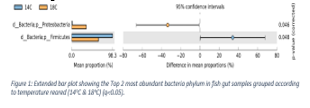INTERACTIVE EFFECTS OF TEMPERATURE REGIMENS AND DIETARY COMPOSITION ON RAINBOW TROUT Oncorhynchus mykiss GUT MICROBIOME
The microbiomes of fish represent complex communities consisting of protists , yeasts, bacteria, archaea, and viruses. These communities populate various regions in the body of fish such as, the skin, gastrointestinal tract, and the gills . The diversity and composition of organisms present in the microbiome are determined by several factors which include, diet, temperature, host genetics, and seasonality . In recent times, the gut microbiota has attracted the attention of nutritionists and health scientists. This is because of the significant role they play in host metabolism, immune response, and health.
A 4x2 factorial experiment was conducted to evaluate the effects of two dietary protein sources (fish meal and plant-based protein), two dietary lipid sources (100% camelina oil and a mixture of 50% fish meal and 50% camelina oil), and two water temperature regimens (14°C and 18° C) on the gut microbiome in rainbow trout (Oncorhynchus mykiss ) over a 150-day rearing period. Juvenile rainbow trout (average weight ± SD, 40 g ± 1.0 g) were randomly assigned to 24 glass aquaria (152 L) with 13 fish per aquaria. The 24 aquaria were randomly assigned to eight treatments with three replicates per treatment. The fish were fed to satiation twice daily for the entire duration of the experiment. Intestinal digesta was extracted from fish at the end of the experiment. The results indicate that temperature affected the gut microbiome diversity and some metabolic functions (q<0.05). In the gut of fish reared at 18°C, there was a higher abundance of genes involved in environmental information processing, metabolism, and cellular processes. The dominant phyla were Proteobacteria and Firmicutes . The most dominant order was Mycoplasmatales. The results also show that temperature x diet interactions affected microbial functional diversity; higher temperature and higher inclusion of dietary plant ingredients correlated a higher abundance of functional genes involved in carbohydrate metabolism, virulence and diseases, and regulation and cell signaling. The results did not show any consistent significant effect of diet on the diversity and function of the rainbow trout gut microbiome . The higher mitochondrial complex activities and numerically lower growth performance and nutrient utilization efficiency (not significant at p>0.05) observed in fish reared at 18°C could suggest that the rainbow trout used in this experiment generated significantly higher energy to maintain homeostasis or cope with stress. This same temperature effect was observed in the gut microbiome diversity and function where fish reared at 18°C displayed higher heterogeneity between samples, were enriched with more abundant taxa, and had higher abundance of genes involved in adapting to the host environment. The study generally showed that rainbow trout can be grown to market size without significant reduction in growth rate, and other performance characteristics including gut microbiome if given a plant-based diet with a 50/50 mixture of animal and vegetable oil.
